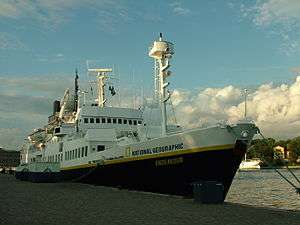National Geographic Endeavour
 The National Geographic Endeavour in the Skeppsbrokajen harbour of Stockholm, August 2008 | |
| History | |
|---|---|
| Name: |
|
| Owner: | Lindblad Expeditions |
| Port of registry: | |
| Builder: | Weser Seebeck, Bremerhaven, Germany |
| Yard number: | 917 |
| Laid down: | 1 October 1965[1] |
| Launched: | 26 February 1966 |
| Completed: | 9 June 1966[1] |
| Converted: | 1983 |
| Identification: |
|
| Status: | In service |
| General characteristics [1] | |
| Type: | Cruise ship |
| Tonnage: | |
| Length: | 89.17 m (292 ft 7 in) |
| Beam: | 14.03 m (46 ft 0 in) |
| Draft: | 5.7 m (18 ft 8 in) |
| Depth: | 9 m (29 ft 6 in) |
| Decks: | 6 |
| Ice class: | DNV ICE-C |
| Installed power: | 2 × MaK 8M582AK (2,387 kW) |
| Propulsion: |
|
| Speed: | 11.5 knots (21.3 km/h; 13.2 mph) |
| Capacity: | 169 passengers |
| Crew: | 64 |
MS National Geographic Endeavour is a small expedition ship operated by Lindblad Expeditions for cruising in remote areas, particularly the polar regions.

The ship was originally a fishing trawler built in 1966 as Marburg, and converted to carry passengers in 1983. First named North Star, then Caledonian Star, she received her present name in June 2001.
On March 2, 2001, the ship was struck by a 30-metre-high rogue wave while crossing the Drake Passage; the wave smashed the windows of the bridge and ruined the navigation and communications equipment, but did not cripple the ship. She was assisted by the Argentine Navy ocean fleet tug ARA Alferez Sobral and reached Ushuaia three days later.[2]
Other ships operated by Lindblad Expeditions are National Geographic Explorer, National Geographic Islander, National Geographic Sea Bird, and National Geographic Sea Lion.
References
- 1 2 3 4 "National Geographic Endeavour (13603)". DNV GL Vessel Register. Det Norske Veritas. Retrieved 2012-09-19.
- ↑ Llegó a Ushuaia el crucero averiado y no podrá zarpar